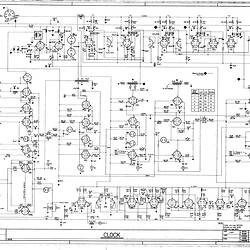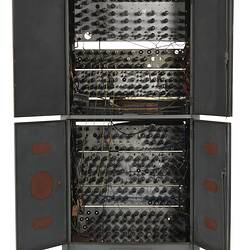The 'clock' in a digital computer generates pulses which control the time and rate at which different operations are to be performed, in much the same way that an orchestral conductor controls the speed at which the orchestra plays and the time that certain instruments commence or cease playing.
The stated 'rate' or 'frequency' of the clock is usually that of the fastest 'tick' and different operations may take tens, hundreds or even thousands of 'ticks' to complete. A typical personal computer in 2007 has a clock rate of several gigahertz, that is thousands of millions of ticks each second. The exact speed of the clock in a modern computer is generally unimportant, as all the operations are synchronized and if the clock runs a little slower the computer will just compute slightly slower.
In CSIRAC the main clock had a frequency of 300 kilohertz, that is about one 10,000th of the frequency of the clock in a PC in 2007.
The main memory of CSIRAC used mercury delay lines. Electrical digital pulses were stored by converting them to acoustic pulses, sending them through the mercury, detecting them at the other end of the line, regenerating them and then resending them down the delay line. The pulses may be thought of as circulating in the delay lines. The delay in the lines was 960 microseconds for each circulation, enabling 16 words, of 20 bits each, to be stored in each line.
Unlike the 2007 computer mentioned above, the clock frequency of CSIRAC and the rate of this circulation had a fixed relationship. The precise time at which items of information could be stored and retrieved from the delay lines depended on the speed of the acoustic pulses through the mercury, which depended in turn on the temperature. This was why the delay lines were kept in a temperature controlled box.
A further refinement was that clock pulses were sent through a special delay line in the box, subject to the same temperature as the memory storage lines. Once they passed through this line the timing of these pulses was compared with the clock and an error signal was fed back to vary the frequency of the oscillator which was generating the main clock pulses. This was effective in keeping the clock in synchronism with the memory circulation, provided the variation remained within a limited range. The frequency of the oscillator could be manually adjusted to the centre of this range by the maintenance engineers by adjusting the main oscillator control whilst observing the timing relationships on an oscilloscope. (Photograph of Ron Bowles making this adjustment. MM 90899.9).
In Sydney, the mercury delay lines were not temperature controlled and the frequency control relied only on the feedback system. Introducing temperature control made the system more reliable. Photographs of CSIRAC in Sydney show the delay lines mounted in front of the memory cabinet, without a temperature controlled box (MM 90899.74).
More Information
-
Keywords
-
Authors
-
Article types






